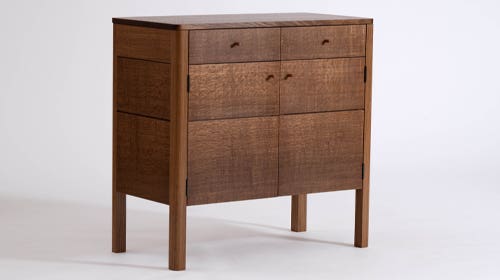Osage orange can resist damage well
Characteristic of an exotic hardwood, it can be used for mantles and bows, but is tough enough to dull cutting knives If you ask locals — wood dealers in Indiana,…
Characteristic of an exotic hardwood, it can be used for mantles and bows, but is tough enough to dull cutting knives
If you ask locals — wood dealers in Indiana, Illinois, Missouri and Oklahoma — about Osage orange, they’ll tell you the wood has had three main uses: wagon wheels, posts for hedge fences and bow staves.
The wood is hard, heavy and dense, has a specific gravity of .80, and is resistant to rot. Osage orange (Maclura pomifera), is also known as bow-wood, bodark, boduck, horse-apple or bois d’arc. Considered by many to be North America’s most durable hardwood, Osage orange is named after the Osage Indian Tribe and the orange refers to fruit of the tree.
“It’s a good exterior wood because, once it is properly dried, it doesn’t seem like any insects will attack it; it doesn’t seem susceptible to rot or even sun damage,” says David Stine, a custom furniture maker in Dow, Ill., who works with Osage orange. “It just seems to last forever outdoors. It machines sort of like ash; it’s crisp, and it really holds an edge well. It’s very dense and hard, almost like when you get heart mahogany, and it doesn’t fuzz up or string out like sycamore. It cuts cleanly and doesn’t have much internal stress once it is dry, so it won’t move on you much.”
“Given the nature of how the tree grows — all twisted and knotted — it makes a great natural fence, but it doesn’t make for too many long straight pieces of lumber,” says Michael Johnson of Johnson Creeks Hardwoods in Mount Carroll, Ill. “It has a yellow range and a lot of what we have stays that color. It keeps a good strong orange and yellow toward the sapwood. And I don’t really understand this because a lot of people say the color doesn’t stay. But we have some turning blocks that have stayed around for years and are still bright.”
Osage orange trees grow to heights up to about 50', but trunks are often short before the tree becomes unshapely. Trunk diameters rarely reach 2' and obtaining long lengths of lumber is difficult. Many think of Osage orange as a large bush rather than a tree. When freshly cut, the heartwood is a lustrous yellow, which over time often develops streaks of orange.
“It’s on the scale of an exotic hardwood,” says John Greeley of Northwest Timber in Indianapolis. “Most of our customers are buying it for making long bows and free-form furniture pieces. We also sell it for mantles or for somebody who wants something with a natural edge on it, a real organic shape.”
“There are a lot of people who are doing bows out of Osage, but they are laminating them, so all they are looking for are decent straight pieces — 4', 5', 6' long of 3/4", 7/8", 1" stock — and they’ll take it from there,” says Johnson. “They’ll just stack-laminate them and they don’t even have to be that long because they can butt them in the laminations. So there is a market for that.”
Since the wood is so dense, working with Osage orange will dull cutting knives. Once properly dried, which can take up to a couple years, the wood is stable and takes a beautiful finish.
“The problem with it when you’re sawing is even though you might have a fairly straight trunk, when you get into it you find out that there are hairline cracks all over the place, and so you are always working around those,” adds Johnson.
“You can plane it and scrape it with hand tools, and do a good job. If it has any size to it at all, it is pretty straight-grained,” Stine says. “If you get a piece that has a real tricky grain, it is going to have so many inclusions and swirls that it isn’t going to be used as a real stick of lumber anyway.”
With patience and some luck, Osage orange can be found in lengths up to 6' to 8' with clear widths between 6" and 12". The wood is sold in 4/4 and 8/4 thicknesses and priced between $7 and $13/bf. Turning stock is readily available.
This article originally appeared in the July 2009 issue.







